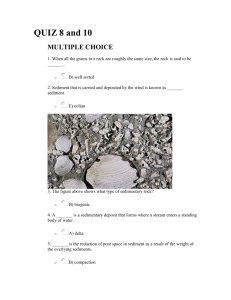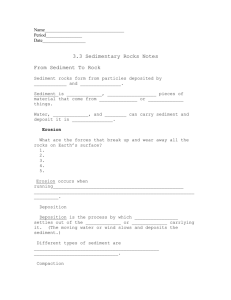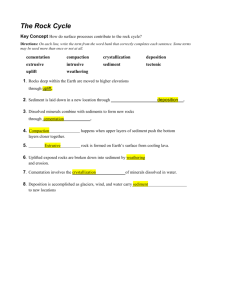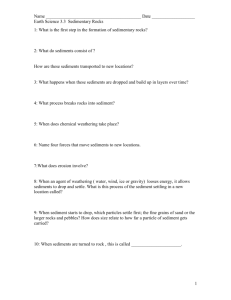Three Types of sediment formation
advertisement
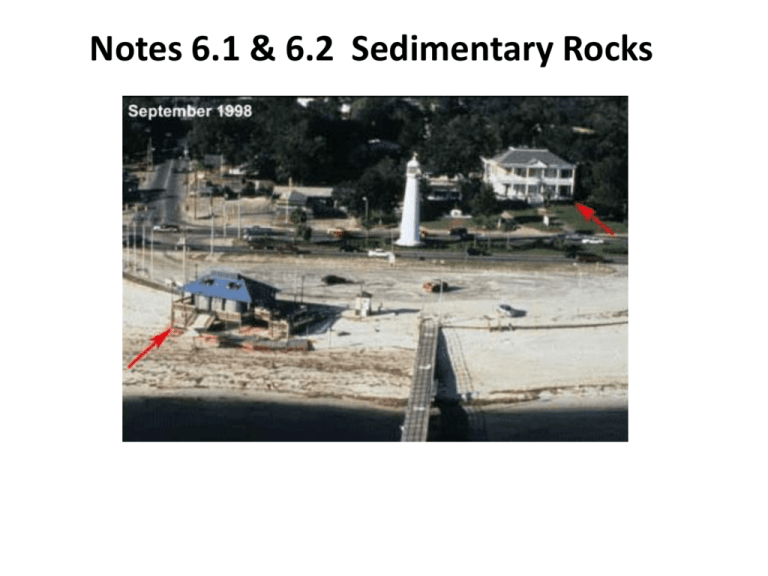
Notes 6.1 & 6.2 Sedimentary Rocks Three Types of Sediment Formation Chemical processes Rock names: Chemical sedimentary, such as halite Describe: Rocks formed by crystals that come out of solution. Plants and Animals Rock names: Biogenic Sedimentary Describe: Rocks formed from plants & animal remains, such as shells. Physical processes Rock names: Clastic Sedimentary Describe: Newer rocks created from breakdown of pre-existing, older rocks that got eroded & transported through water, wind, or ice. Sediment Characteristics within sedimentary rock Source Rocks Effect: Source rocks erode into sediments. These sediments can eventually form into new rocks or rock layers. Stratification Describe: Different layers seen within a rock or rock bed. particle size Measured using: Wentworth Scale. Describe: Particles undergo differ levels of erosion during transport. The level & type of erosion determine grain sizes formed from the particles. Sediment Roundness Describe: Rock edges are worn away differently by their transport methods (water, wind,…) Softer minerals wear away faster than harder minerals. Sorting Describe: Well-sorted = rocks are separated into same-sized particles. Not well sorted= rocks of all sizes are mixed together. Method: The transport method influences how well particles are sorted. Wind- Sorts particles very well; can only pick up small sizes. Water- Sorts fairly well; can’t pick up very large particles. Ice- Does not sort well!! It can carry a wide range of sizes. Formation of clastic rocks Sediment transport Main Points: Wind, water, & ice can carry sediment. Sediment Load- The number of particles a transporting agent can carry. Physical load- refers to objects being carried Chemical load- refers to ions in solution. Increasing kinetic energy Effect: Increasing the kinetic energy (KE) of a transporting agent increases the number & size of particles that can be carried. Sediment Deposition (decreasing kinetic energy) As KE of a transporting agent decreases, sediment falls Main Points: out & gets deposited. Sediment Lithification Compaction 1. Sediment weight increases & pushes down w/ greater force. 2. Particles are pushed closer together; sediment gets less thick. 3. Pore spaces get smaller & water is squeezed out. Cementation 1. Minerals precipitate out of solution while flowing through crushed sediment. 2. This precipitate fills tiny pore spaces in the sediment . 3. This precipitate acts like cement; it binds small grains and hardens them into rocks. Mineralogic Constant compaction changes mineral composition of Rocks. changes: Recrystallization New mineral grains can grow larger than the original grains. Creates interlocking crystals that form very hard rocks. Continental Depositional Environments Describe: Where sediment are deposited on Earth’s continents. Examples Glaciers, glacial deposits, floodplains, lakes, Alluvial fans, sand dunes, …. Marine Depositional Environments Describe: Examples Where sediments are deposited in seas or oceans. Submarine fans, deep ocean floor, reefs Transitional Depositional Environments Describe: Where sediment is deposited between Earth’s land & ocean. Examples Estuaries, barrier islands, deltas, beaches, tidal lagoons, … Fossils Evidence Of: Preserved remains or traces of organisms that lived in the past are found in sedimentary rocks. Ripple Marks Evidence Of: “Waves” in sandy material can indicate currents once moved over the surface before being buried. Structural Evidence of the Past Found in Sedimentary Rock Mud Cracks: Clay-rich sediment preserves cracks that form when it dries. Cross-beds Evidence of: Show that air or water carried the sediment load in mounds. Clastic Rock Classification Grain Texture Types: Coarse: Gravel, Cobble, Boulder over 2mm & round Medium: SAND 1/16 -2mm & angular Fine-grained: SILT 1/256 -1/16 mm & gritty Very Fine-grained: CLAY less than 1/256 & not gritty Biogenic & Chemical Rock Classification Explain: Mineral composition of a rock helps identify the rock’s name.


